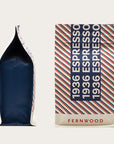



1936 Espresso
A decadent and full bodied espresso.
Cup Profile:
Sweet with a bright acidity, notes of dark chocolate and marmalade.
Blend:
75% Brazil, Fazenda Serrado (natural process)
25% Ethiopia Chelchele (natural process)
- Save 10% every time
- Earn 1.5x reward points
- First access to new offerings
- Swap, pause, or gift anytime
Brew Guide
Our head roasters have always vouched to brew what tastes good to you. We use these guides as a starting point and a general process through each method to brew the best coffee.




Worth A Try



